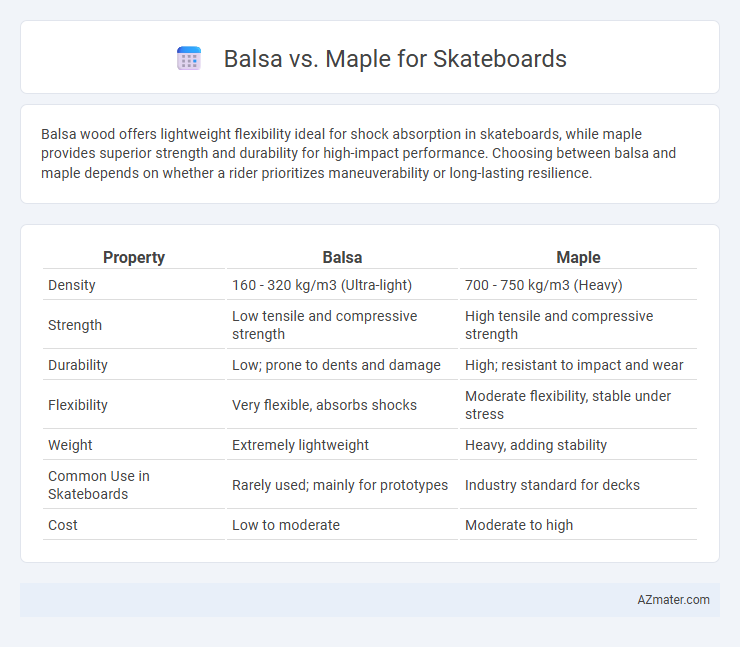Balsa wood offers lightweight flexibility ideal for shock absorption in skateboards, while maple provides superior strength and durability for high-impact performance. Choosing between balsa and maple depends on whether a rider prioritizes maneuverability or long-lasting resilience.
Table of Comparison
| Property | Balsa | Maple |
|---|---|---|
| Density | 160 - 320 kg/m3 (Ultra-light) | 700 - 750 kg/m3 (Heavy) |
| Strength | Low tensile and compressive strength | High tensile and compressive strength |
| Durability | Low; prone to dents and damage | High; resistant to impact and wear |
| Flexibility | Very flexible, absorbs shocks | Moderate flexibility, stable under stress |
| Weight | Extremely lightweight | Heavy, adding stability |
| Common Use in Skateboards | Rarely used; mainly for prototypes | Industry standard for decks |
| Cost | Low to moderate | Moderate to high |
Introduction to Skateboard Deck Materials
Balsa and maple are two popular materials used in skateboard deck construction, each offering distinct performance characteristics. Maple, particularly Canadian hard rock maple, is renowned for its durability, stiffness, and ability to withstand heavy impacts, making it the industry standard for most skateboard decks. Balsa wood, while significantly lighter and more flexible, is less common and typically favored for custom or lightweight boards where maneuverability and ease of control are prioritized over extreme durability.
Overview: Balsa vs Maple Wood Properties
Balsa wood is exceptionally lightweight and soft, offering excellent shock absorption, which makes it less durable but perfect for beginners or lightweight skateboard decks. Maple wood, specifically hard rock maple, is denser and significantly more durable, providing superior strength, stiffness, and resistance to impact, making it the preferred choice for professional and high-performance skateboards. The balance between balsa's flexibility and maple's toughness determines the skateboard's responsiveness and lifespan, influencing rider performance and comfort.
Weight Comparison: Balsa vs Maple Skateboards
Balsa wood skateboards are significantly lighter than maple ones, typically weighing around 10-20% less, which enhances agility and aerial maneuvers. Maple, known for its density and durability, offers greater strength but results in a heavier deck, often weighing between 2.2 to 3.3 pounds compared to balsa's lighter 1.5 to 2.5 pounds. This weight difference influences ride dynamics, with balsa providing faster acceleration and maple delivering superior impact resistance and longevity.
Strength and Durability Factors
Maple offers superior strength and durability for skateboards due to its dense, hard grain and resistance to impact, making it ideal for heavy use and high-impact tricks. Balsa, although lightweight and flexible, lacks the toughness required for long-term durability under intense stress, often leading to quicker wear and potential breakage. Skateboard decks crafted from maple wood maintain structural integrity and provide consistent performance, which is critical for skaters demanding reliable strength.
Flexibility and Performance
Balsa wood offers superior flexibility due to its lightweight and soft structure, making it ideal for skateboard decks that require enhanced shock absorption and responsive performance. Maple, known for its dense grain and hardness, provides exceptional durability and snap, delivering consistent pop and control for aggressive riding styles. Choosing between balsa and maple depends on the desired balance between flexibility and performance, with balsa favored for smoother rides and maple excelled for high-impact tricks.
Environmental Impact and Sustainability
Balsa wood, known for its light weight and rapid growth rate, offers a more sustainable option for skateboard decks compared to traditional maple, as it requires less energy and water during cultivation. Maple, predominantly used in skateboard manufacturing, has a longer growth cycle and higher density, resulting in greater environmental strain through deforestation and resource consumption. Choosing balsa wood can reduce carbon footprints and promote eco-friendly skateboard production without sacrificing performance.
Price Differences and Value
Maple skateboards typically cost more due to the wood's density and durability, offering superior strength and longevity for frequent riders. Balsa skateboards are less expensive, appealing to beginners or casual users because of their lightweight nature but sacrifice durability and performance. When considering value, maple provides a better return on investment for long-term use, while balsa suits budget-conscious buyers prioritizing lightness over resilience.
Best Use Cases for Balsa Decks
Balsa skateboard decks excel in ultra-lightweight performance, making them ideal for riders prioritizing quick maneuverability and aerial tricks. Their natural shock absorption benefits long-distance cruising or technical street skating where reduced board weight enhances control and precision. Balsa's softness compared to maple results in less durable decks, so they are best suited for low-impact skating or riders seeking maximum responsiveness over longevity.
Best Use Cases for Maple Decks
Maple decks excel in durability and strength, making them ideal for street and park skateboarding where impact resistance is crucial. Their dense grain structure provides superior pop and stability, supporting tricks that require precision and control. Maple's resilience against wear and tear makes it the preferred choice for skaters who demand longevity from their decks in aggressive riding conditions.
Conclusion: Choosing the Right Material for Your Ride
Choosing between balsa and maple for your skateboard depends on your riding style and priorities; maple offers superior durability and pop, making it ideal for street and park skating, while balsa provides lightweight flexibility suited for cruising and technical tricks. Maple's dense grain structure ensures longer board life and consistent performance under impact, whereas balsa's softness absorbs shock with less weight but sacrifices strength. Evaluating factors like deck longevity, weight preference, and intended terrain will guide you to the optimal material for your ride.

Infographic: Balsa vs Maple for Skateboard
 azmater.com
azmater.com